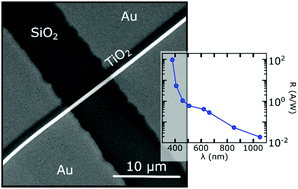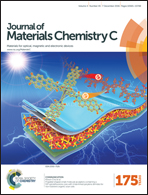Highly responsive UV-photodetectors based on single electrospun TiO2 nanofibres†
Abstract
In this work we study the optoelectronic properties of individual TiO2 fibres produced through coupled sol–gel and electrospinning, by depositing them onto pre-patterned Ti/Au electrodes on SiO2/Si substrates. Transport measurements in the dark give a conductivity above 2 × 10−5 S, which increases up to 8 × 10−5 S in vacuum. Photocurrent measurements under UV-irradiation show high sensitivity (responsivity of 90 A W−1 for 375 nm wavelength) and a response time to illumination of ∼5 s, which is superior to state-of-the-art TiO2-based UV photodetectors. Both responsivity and response speed are higher in air than in vacuum, due to oxygen adsorbed on the TiO2 surface which traps photoexcited free electrons in the conduction band, thus reducing the recombination processes. The photodetectors are sensitive to light polarization, with an anisotropy ratio of 12%. These results highlight the interesting combination of large surface area and low 1D transport resistance in electrospun TiO2 fibres. The simplicity of the sol–gel/electrospinning synthesis method, combined with a fast response and high responsivity makes them attractive candidates for UV-photodetection in ambient conditions. We anticipate their high (photo) conductance is also relevant for photocatalysis and dye-sensitized solar cells.


 Please wait while we load your content...
Please wait while we load your content...